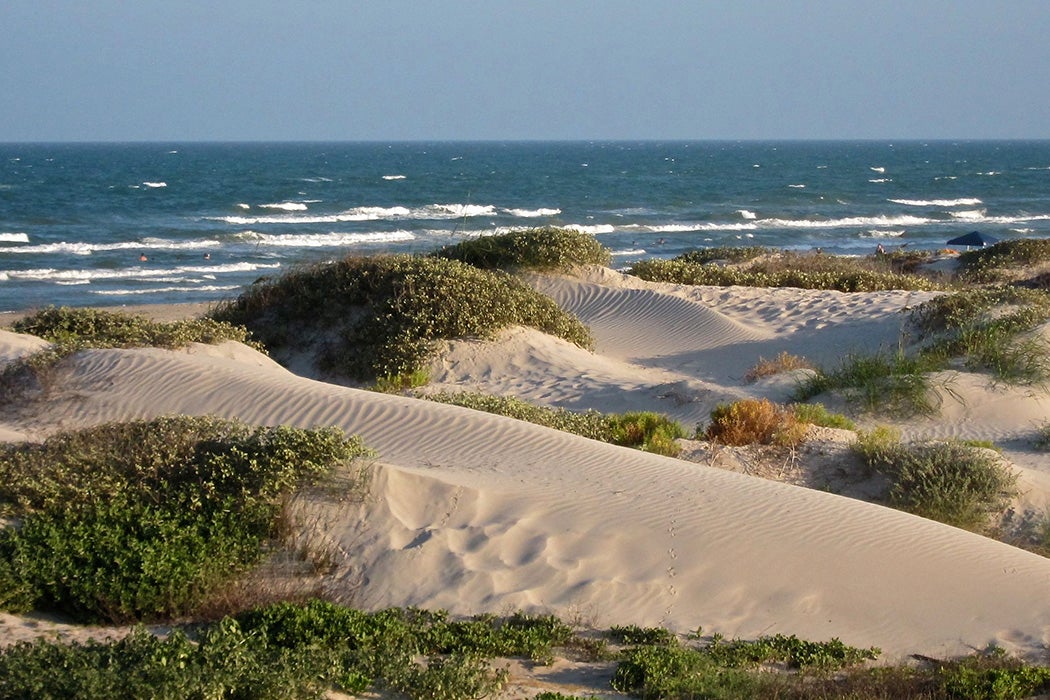Sand dunes, perhaps taken for granted as features of the beachfront, are good for much more than picturesque long walks on the beach; in fact, some beaches even advise against walking on dunes to protect the tenuous ecosystems they host. Two recent studies published in the Journal of Coastal Research demonstrate just how critical a role dunes play in absorbing the impact of hurricanes, both as physical landmasses and as the substrate for vegetation. As hurricane season continues to lengthen and become more severe, the need to understand how to mitigate and recover from hurricane impacts increases. Both studies highlight the potential of dunes to be managed as so-called adaptive barriers against severe weather.
A study by Jacob M. Sigren, Jens Figlus, Wesley Highfield, Rusty A. Feagin, and Anna R. Armitage at Texas A&M at Galveston developed models to economically quantify how much damage dunes prevented on the upper Texas coast in Galveston and nearby Bolivar Peninsula during Hurricane Ike in 2008. Using LiDAR imagery of the coastlines before and after the hurricane, Sigren et al. correlated features of dunes such as vegetation coverage and amount of sediment with the dollar value of post-storm insurance claims on properties near each respective dune. These “ecological, built-environment, and geographic variables” were then used to model the value of dune ecosystems (based on the damage ultimately sustained) and the expected value of damage if the dunes had been of minimal size.
Sigren et al. “estimate that the total mitigation value of dunes”—that is, how much money in damages dunes prevented—“within the study area was $8.43 million,” which may be a drop in the bucket of the estimated $27.5 billion of damage from Hurricane Ike. But, calculating the value of each individual dune, so to speak, the researchers estimate that dunes saved an average of $8200 per property—no small cost for a homeowner after one weather event.
The researchers conclude that “coastal sand dunes, in regards to both vegetation area and sediment volume, significantly reduced sustained property damage for portions of the Texas coast during Hurricane Ike.” With some spatial variability, the results show that “investment in certain critical areas…could lead to a higher return on dune investment” in mitigating future storm damage, such as nearby older (and thereby more valuable and damage-prone) structures or in areas currently under-protected by dunes.
Sigren et al. admit, however, that dunes are not homogenous and a dune’s composition—determined by the vegetation it supports and the sediment the vegetation retains—is a key factor in its ability to absorb storm effects.
The particularities of dune vegetation in Galveston and Bolivar were not visible nor noted by Sigren et al. study, but along the also-hurricane-prone East Coast, scientists at the University of North Carolina have studied how vegetation presence and dune shape, or morphology, changed in the field before and after Hurricane Isaias in 2020.
In a study published in 2023, Sheri A. Shiflett and Joni T. Backstrom subdivided the coast of Holden Beach, a barrier island in southeast North Carolina, into regions where they catalogued loss of sediment and presence of dune grasses and shrubs before and after Hurricane Isaias. They found that “vegetation provide[d] approximately 30–40% greater reduction of erosion and dune scarp than bare sand.”
They particularly studied plants such as sea oats, American beach grass, and bitter panicum, which they characterized as “dune builders.” These plants grow rapidly vertically and laterally and have long roots. In addition, their growth can be stimulated by burial, as might occur after a major weather event. According to Shiflett and Backstrom, these traits contribute to the plants’ ability to “accumulate sediment, […] and may build a variety of dune morphologies,” or dune shapes.
Weekly Newsletter
As may be expected, the study found that dunes were substantially eroded following the hurricane, but there was “reduced impact” on dunes and vegetation in “a wider, stabilized dune area” than in a “narrower, less mature, and [more] actively managed” dune. To increase storm resilience of dunes and coastlines, Shiflett and Backstrom counsel “continued planting of a mixture of dune grasses, especially in areas where dunes are scarped [i.e. steep] or narrow.”
Both studies attest to the importance of understanding dunes and their ecological potential to meet the ever more urgent needs for hurricane protection while also cultivating native ecosystems. Dunes already play a critical role in protecting coastlines and their communities, as absorbent and ecologically suitable barriers. They “offer a unique opportunity of bioengineering green infrastructure,” write Sigren et al., and “should play an integral role in coastal hazard mitigation strategies.”







